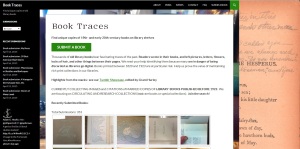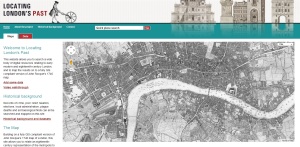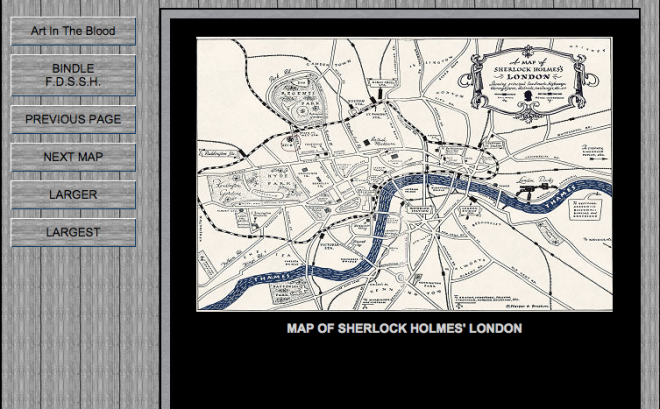Here’s the link to our project!
[Emily DeFranco, Alexandra Dudas, Christine Wohltjen]
https://supernaturallocations.wordpress.com/
-It’s been fun!
Category for all blog posts for Spring 2015
Here’s the link to our project!
[Emily DeFranco, Alexandra Dudas, Christine Wohltjen]
https://supernaturallocations.wordpress.com/
-It’s been fun!
Our final project is a digital archive that contains all of the oldest newspapers that are still in publication today throughout all the 50 U.S. states.
Here is a link to our digital humanities project that was produced by: Maria Hutman, Kristen Warfield, Raisa Lassance, and Lauren Gao.
http://papersofthepast.omeka.net
Hey everyone,
Hope you all enjoy our blog on Death Eaters in the Harry Potter series! We will explain more about it tomorrow, but for now, have fun looking around.
https://deatheaterstudies.wordpress.com/
-Hannah, Jen, and Tina
A good digital humanities project should incorporate the following:
If a project includes all of these aspects, such as the Charles Booth Archive or the Rosetti Archive, then we can learn from them in hopes of creating our own. The scholarly nature of both archives adds to their legitimacy; in fact, thanks to each sites’ design, the presentation of information is transparent, and bibliographic notes are included.
Digital Humanities allows scholars to ask new questions that would have been almost impossible prior to the proliferation of the internet. Collaboration throughout the world is much easier now, which increases the variety of viewpoints for a particular subject.
Another advancement that promotes new questions is the use of interactive maps which can be toggled on or off. This gives scholars a tool to investigate that would be either too difficult or too time consuming to recreate prior to digitalization.
These are just two of many innovations in thinking digital humanities has hoisted upon the world; it will be interesting to see how the discipline grows and changes with time.
1. Clear Objective/Topic
The purpose of the project should be clear, without users needing to dig deeper to find out why the site or project exists. Without a clear objective in mind, projects risk becoming too expansive, scattered, and/or diluted in their content and/or message, thereby limiting their relevance and usability.

2. User Friendly/Easy to Navigate
A good Digital Humanities project needs to be easy for users to navigate and use. An over-complicated design or interface makes the project less useful in the long run, since users need to be able to find what they’re looking for as quickly and easily as possible in order for the project to have any merit for scholarly/research purposes.
3. Visually Appealing/Appropriate
A good Digital Humanities project should be as aesthetically pleasing as possible, without the design distracting or deviating from the purpose of the project. This keeps the project interesting and engaging, and, if done right, can help further immerse users in the information contained within.

4. Scholarly
Digital Humanities projects should aim to be as scholarly as possible, providing relevant, consistent, accurate information that can be effectively used for research purposes.

5. Collaborative
It’s quite useful for a Digital Humanities project to be collaborative. Some projects allow users from around the world to contribute, while others are simply open to be updated over time by the researchers involved, never quite being “finished.”
How do Digital Humanities Projects Allow Scholars to Ask New Questions?
Digital Humanities allows scholars to ask new questions by making connections between topics and types of data that were never before so easily comparable. For example, a GIS mapping project can provide comparative, multi-era overlays of the same area, showing differences over time in some specific category, and it is able to do this all in the same space, in an interactive way. Digital Humanities makes the easy effortless, the possible easy, the difficult possible, and, in some cases, the impossible a reality.
Design
Time and time again, clean, organized, aesthetic design and visuals on turn up as key to any Digital Humanities project we have done in class so far. For example, GIS mapping projects should not have all of its data sets appear simultaneously, and should give the viewer the option to toggle on/off individual data sets. In the case of Digital Archives, once again, choice of colors and images used on the home page can have a substantial impact on how the user may come to understand what the theme binds together the information in that particular archive.
Scholarly
This quality is what separates reliable DH projects and questionable ones. All the information used in any particular project should be traceable to their original source, whether it be primary or secondary, especially if the information used did not belong to the makers of the DH Project. On a Digital Archive, this would appear perhaps at the end of each object page or whenever a reference to information that was obtained outside the DH project itself.
User Friendly
Considering that every individual who makes or uses a DH project are not from computer science disciplines themselves, navigating these projects should feel “organic” or fairly easy to learn. Book Traces is one example of such, where the form to fill out the book submission is extremely easy to understand, and even provides an example on the side.
Interactive
On of the advantages of a DH project over physical paper representations of it, is that the user is able to interact with the project by manipulating when certain bits of data or information are shown at a time. The overlay feature of GIS mapping projects is one example of this, or clicking on a pin to reveal more information about that location is another. A not so good example of this would be the maps shown on the “Art in the Blood” fan project.
Collaborative
Last, but not least, DH projects allow for extensive amounts of collaboration with individuals who need not presently be there to do so. So as long as he or she may have access to the tools online needed to make the project, any person can continue on another’s work so as long the project is open to the public. Again, Book Traces is an elegant example of this as contributing to the project’s storehouse of 19th century Marginalia is quick, but thorough.
Through this course I have learned a great deal about what good qualities make up a Digital Humanities Project. The first quality which is important is being user-friendly. The Digital Humanities are significant because they aim to educate and reach out to a large group of people, and the way to do that is to make your project user-friendly. One project which fails in it’s user-friendliness is Sherlockian.net. This project fails because it does not make the information on the site widely available to its users, it’s incredibly confusing and takes you down many different paths you weren’t necessarily looking for.
Another important quality of a Digital Humanities project is design, specifically choosing a theme and sticking with it. This is significant because it sets the mood and tone for the information your project is explaining, and it allows users to get a more in-depth feel for the information. One project which does this well is Songs of the Victorians. This project maintains a Victorian theme and style which allows the reader to get more involved within the information. It also sets the scene for the user that the information is explaining.
A third important quality of a good Digital Humanities project is having a collaborative effort. This is significant because it allows for an expansive amount of information to be collected by anyone to be compiled and used to study something. By having a collaborative effort you are able to reach out to more people and have a wide variety of individuals become involved within the project, whilst still collecting a great amount of academic information that one wouldn’t normally be able to collect.
A fourth significant quality of a good Digital Humanities project is having academic sources and credited information. By making your information and project academic, you give your project a higher amount of credibility. Furthermore, it allows for others to use your project as a source itself, giving students and other academia scholarly materials.
Lastly, a final quality of a good Digital Humanities project is interactivity. By having your project be interactive, you give users a fun way to learn new information. It helps users who are more hands-on learners an easier way to discover new information while also letting users have fun!
From taking this course, we sure have looked at a lot of different digital humanities projects! From looking at them at the surface to learning how some of them were made, a few very important aspects of some of my favorite examples exhibited the qualities of a good DH project!

As saucy as this may sound, a project must be easy on the eyes! In other words, working with fonts, color schemes and site layouts can really add to the professionalism and visual appeal to a project, thus making people more inclined to read/ view more of all of your hard work! If a website is really difficult to navigate, it can be very frustrating for users.

Delving into a project based off of a personal interest is fantastic, but it also helps to choose a project on a topic that would appeal to a large array of people, such as students or scholars. If a project topic is too oddly specific to just one idea that not many people know about or not many people are effected by, I’m not so sure that it would necessarily be considered a good project. However, just because something is not commonly known does not mean that it will not interest people!

A successful DH project is most commonly supported by its various staff members behind it. For example, in Locating London’s Past, a staff of educators, design experts, planners and historians were all behind the same project – and this factor, in my eyes, is what made it so interesting and humbling at the same time! Although these people were generally from the same area, all of their paths crossed due to their expertise in one field that was then built upon by the next member and so on. As any student who has had the misfortune of being stuck in a less than productive group for a group project, I can only imagine that this collaborative effort, while very useful, also could have become a large source of stress because so many people were involved.
This last quality is probably the most important one from my condensed list. Everything that is included in a DH project must be true – this means checking, double checking and triple checking information and also retrieving it from reputable sources, whether it be from a scholarly study or an online database such as the Old Bailey Proceedings database. If information compiled within a DH project is incorrect, the entire project could be at stake and all of one’s hard work could be invalidated by the presence of incorrect information.
One of the most prominent of DH means that interests me the most is trends in data. If a DH project presents an issue such as a statistic involving crime, health, poverty etc., as a journalist I am very interested in the history behind the issues. What does this mean? Why is it important now? How were things different five years ago? Ten years ago?
Through the digital means of DH, we are easily able to seek out answers to these questions at the click of a mouse. We are not only utilizing the technology that we have for information, but getting in-depth analysis of the data that has been retrieved by means of people all around the world with more advanced technologies in their possession than us. By discovering a DH project, we are not only learning about the specific topic but also the amazing tools that were used to put it together in the first place. By becoming more aware of these technologies, scholars can then inquire just how these means work, where they come from, how much they cost, what else they can be used for and also how they were utilized for a specific project.
The connection that DH creates between educational professionals, students and scholars is a very broad but intriguing relationship. Instead of spending hours in a library doing research on a topic, students are able to look into a DH project on the same topic that someone halfway across the world had put many years of hard work into. And the amazing thing about that relationship is that we, as students in a DH class, have the potential to spark inquiries and views from scholars from halfway around the world with our final projects as well! A thought that is very exciting and promising.
The qualities of a good digital humanities project include:
1. Usefulness
A good project is useful to scholars from varying disciplines, offering resources for more extensive study of a topic when viewed from different perspectives. The project can then allow conversation between subjects or disciplines. The Old Bailey Archive, for instance, is an excellent example of a resource made accessible to a larger audience that allows the visitor to view a large collection of reports from the court’s criminal trials. The information gained from the project could be useful for various academic disciplines, from a study in the historical contexts of specific crimes to the frequency of crime in certain areas of London. These multiple studies can be used either apart or in conjunction with one another to take full advantage of the information provided by the archive.
2. Collaboration
One of the things that makes digital humanities unique is the ability for its users to collaborate on projects and furthermore on the comprehension of those projects. Just as the project should allow for the conversation between disciplines, it should be able to spark conversation between scholars about the topics it covers. The creators should work together to produce a tool that offers a complexity that is lacking in small, single-disciplinary projects. Just a brief glance at the “Project” pages of some of these tools reveals an extensive list of contributors from different faculties and with varying areas (and levels) of expertise.
3. Design
The design of a project should be visually engaging and simple (to a degree). It should remain aesthetically pleasing without being gaudy, and the designer should refrain from making it too busy. The design should compliment the resources provided, rather than distracting from the information. The Ninteenth-Century Disability Cultures & Contexts archive has a clean, attractive design that does not take away from the project’s text. Less professional-seeming projects like word clouds run the risk of being aggressively tacky and prevent the viewer’s full focus from being on the text. (The default results from the Voyant tool still make me cringe.)
4. Accessibility
The tool should be easy for anyone – professional or student – to understand. This ties into the design, of course, but also to the specific presentation of information. If the language used is too technical, those who aren’t pretentious enough may not be able to comprehend what is being presented. As stated above, one of the most crucial aspects of digital humanities projects is the conversations they create between subjects and scholars. Just like any old conversation, communication can’t exist unless there are efforts made at mutual understanding.
5. Innovation
What truly allows scholars to ask new questions via digital humanities projects is the presentation of new perspectives on old topics. As information is continually published in innovating ways and unique resources are produced, the ability for people to gain alternative understandings of the subjects is increased. These understandings translate to new answers to questions – old or new – that were previously not considered, well, answerable. Hammerich’s article “Humanities Gone Spatial” suggests just a few questions that can be posed and sought to answer through the use of digital humanities, like “Would Robert E. Lee have been able to see Union forces on the far side of the battlefield when he ordered the notorious Pickett’s Charge?” These questions and answers can span many existing disciplines and may even create new ones. The field of digital humanities allows for the interpretation and analysis of information that was not possible in the past.